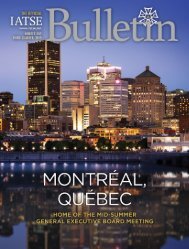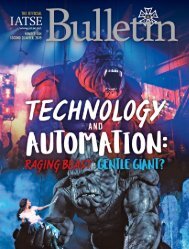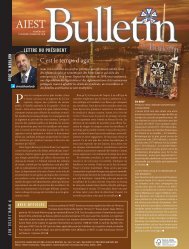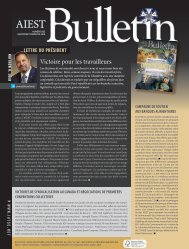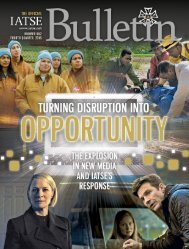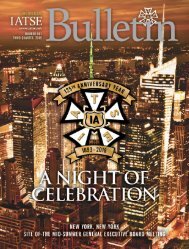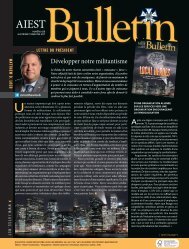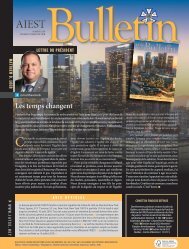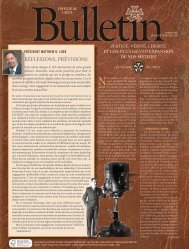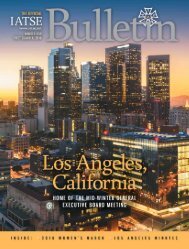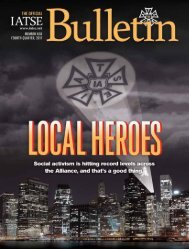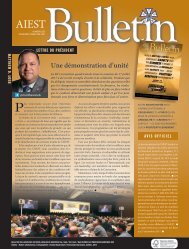IATSE-2nd2018_web
You also want an ePaper? Increase the reach of your titles
YUMPU automatically turns print PDFs into web optimized ePapers that Google loves.
in a day or a week, whereas with live TV it took much longer.<br />
This resulted in less work for <strong>IATSE</strong> members who had been<br />
working not only on the production of shows but on the<br />
rehearsals as well. Worst of all, shows recorded on tape could<br />
be re-broadcast many times over, thereby providing networks<br />
with a source of program material that dispensed with the<br />
necessity of IA crafts.<br />
Additionally, the development of mobile video cameras used<br />
in the field to cover news stories sparked a heated controversy<br />
over who would represent the camera operators. Although<br />
<strong>IATSE</strong> argued that the news motion picture crews possessed the<br />
know-how and experience to cover news in the field and should<br />
therefore be awarded the jurisdiction over the so-called ENG<br />
(Electronic News Gathering) function, the networks awarded<br />
the work to IBEW or NABET.<br />
Litigation resulted, but for the most part the award of<br />
jurisdiction by the networks was upheld by the NLRB, by<br />
arbitrators, by the courts in some instances, and by the impartial<br />
umpire under Article 20 of the AFL-CIO Constitution.<br />
The end result was that the engineering unions by and large<br />
took over the function of gathering news in the field through<br />
electronic cameras using videotape. Many IA members who had<br />
done this work in the past were required to become members<br />
of IBEW or NABET to stay employed by the networks.<br />
But <strong>IATSE</strong> kept at it. And in 1964, President Walsh signed<br />
an agreement with the Association of Motion Picture Producers<br />
and the Alliance of Television Film Producers 4 that covered<br />
videotape productions.<br />
Later on, videotape had a profound impact on <strong>IATSE</strong><br />
members in other ways. Tape could be reused, and did not<br />
require as much careful lighting as film. Video cameras were<br />
perfected to the point where virtually anyone could use one. The<br />
result was that many “independent” producers began to make<br />
video films for television as well as movies.<br />
LANDMARKS OF TV NEWS<br />
In the late 1950s and early 1960s, several major events<br />
impacted society and network news programming — and the<br />
work lives of <strong>IATSE</strong> members. The U.S. visit of Soviet leader<br />
Nikita Khrushchev kept hundreds of IA camera operators,<br />
sound technicians, electricians, grips, gaffers and other technical<br />
personnel working around the clock to cover the historic occasion.<br />
The election of John F. Kennedy as President in 1960 was<br />
another major event that transformed TV. The first Kennedy-<br />
Nixon debate was at a CBS affiliate, WBWM in Chicago. Station<br />
technicians were required to meet all kinds of demands on<br />
the part of the candidates’ entourages, including painting the<br />
background on the set two times, the last time shortly before the<br />
debate was to begin. The <strong>IATSE</strong> members on the set of that first<br />
debate helped make history.<br />
The Kennedy inauguration lasted all day and into the<br />
night, just as coverage of his assassination would preoccupy<br />
tens of millions of Americans just a few years later. In the latter<br />
instance, television served the dual purpose of informing the<br />
public and helping the nation to grieve. The images gathered by<br />
<strong>IATSE</strong> technical crews were emotionally riveting. Forever after,<br />
IA members would find themselves in the midst of national<br />
and international events knowing that Canadian and American<br />
citizens were relying on them to bring news into the living<br />
room. Wars, urban riots, the conquest of space, live telecasts of<br />
congressional hearings on everything from civil unrest to the<br />
possible impeachment of a President — IA members made it<br />
possible for the people to be eyewitnesses to all of these pivotal<br />
events.<br />
4<br />
The two organizations merged in 1982 and became the Alliance of Motion Picture and Television Producers.<br />
45



